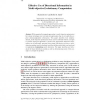Free Online Productivity Tools
i2Speak
i2Symbol
i2OCR
iTex2Img
iWeb2Print
iWeb2Shot
i2Type
iPdf2Split
iPdf2Merge
i2Bopomofo
i2Arabic
i2Style
i2Image
i2PDF
iLatex2Rtf
Sci2ools
GECCO
2003
Springer
2003
Springer
Effective Use of Directional Information in Multi-objective Evolutionary Computation
While genetically inspired approaches to multi-objective optimization have many advantages over conventional approaches, they do not explicitly exploit directional/gradient information. This paper describes how steepestdescent, multi-objective optimization theory can be combined with EC concepts to produce improved algorithms. It shows how approximate directional information can be efficiently extracted from parent individuals, and how a multiobjective gradient can be calculated, such that children individuals can be placed in appropriate, dominating search directions. The paper describes and introduces the basic theoretical concepts as well as demonstrating some of the concepts on a simple test problem.
Basic Theoretical Concepts | GECCO 2003 | Multi-objective Optimization | Multi-objective Optimization Theory |
| Added | 06 Jul 2010 |
| Updated | 06 Jul 2010 |
| Type | Conference |
| Year | 2003 |
| Where | GECCO |
| Authors | Martin Brown, Robert E. Smith |
Comments (0)

